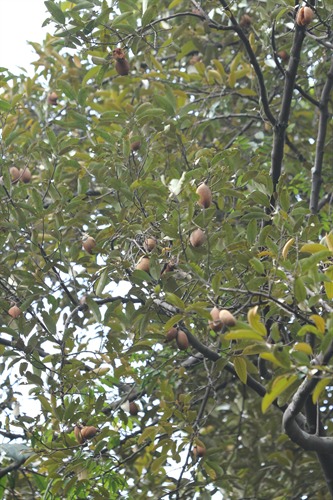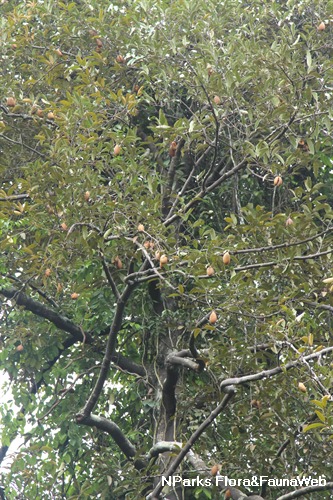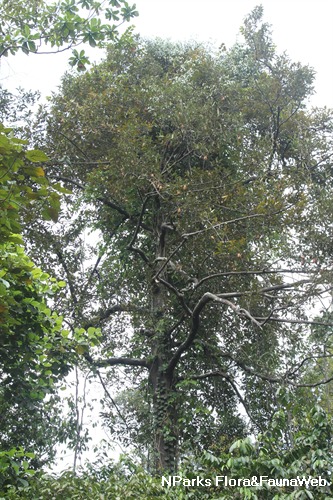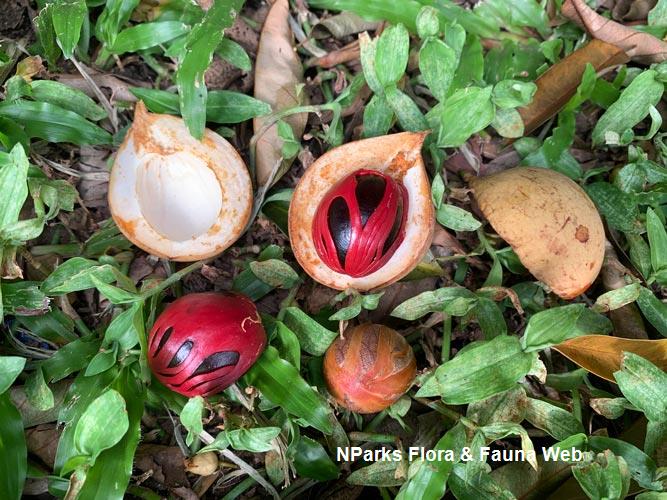
Back
Myristica cinnamomea King
| Family Name: | Myristicaceae |
| Common Name: | Mayong Pahomh, Mendarah, Pala Bukit, Pala Semang, Pendarah |
Name
Classifications and Characteristics
| Plant Division | Angiosperms (Flowering Seed Plants) (Dicotyledon) |
|---|---|
| Plant Growth Form | Tree (Medium (16m-30m), Small (6m-15m)) |
| Lifespan (in Singapore) | Perennial |
| Mode of Nutrition | Autotrophic |
| Plant Shape | Irregular |
| Maximum Height | 10 m to 30 m |
Biogeography
| Native Distribution | Sumatra, the Malay Peninsula, Singapore, Borneo, the Philippines, and Mindanao |
|---|---|
| Native Habitat | Terrestrial (Primary Rainforest, Mountain, Freshwater Swamp Forest) |
| Preferred Climate Zone | Tropical |
| Local Conservation Status | Native to Singapore (Critically Endangered (CR)) |
Description and Ethnobotany
| Growth Form | It is a tree 10–30 m tall, its base fluted with buttresses, and often with a few stilt roots. |
|---|---|
| Foliage | Its spirally arranged, stalked leaves have papery to thinly leathery leaf blades that are oval-oblong to oblong-lance-shaped, with a pointed tip, glossy olive-green above, grey-brown or silvery-brown below, inconspicuously covered with coppery, golden, or silvery brown hair up to 0.2 mm long, sometimes becoming hairless with age, with midrib flat or somewhat raised above, and have 10–17 lateral veins. |
| Flowers | The plant is dioecious, producing male or female flowers on different plants. Its flowers are greenish to yellow, red inside, covered with yellow-brown hair 0.1 mm long, with an unpleasant smell, and are arranged among the leaves in stalked flowering clusters that are covered with mealy hair 0.1–0.2 mm long. Its male flowering clusters are 1–2.5 cm long and 5–8-flowered. Its female flowering clusters are an up to 3 mm stalked wart, bearing 2–4 flowers. |
| Fruit | Its fruit is broadly ellipsoid or oblong, yellow-brown, 5–9 by 2.5–5 cm, densely covered with mealy rusty hair 0.1 mm long, with a 8–15-mm thick fruit wall, and arranged in a 0.5–2-cm wide cluster of 1–3 fruits. Its seeds are ellipsoid, blackish, 3.5–5.5 cm, covered with a thin bright or dark red aril, and not variegated. |
| Habitat | It grows in lowland and hill mixed dipterocarp forests, ridge forests, kerangas, and transition to submontane forests up to 1000 m altitude. |
| Associated Fauna | Its flowers are insect-pollinated. |
| Cultivation | It can be propagated by seed. |
| Etymology | Greek myristica, myrrh-fragrant, referring to true nutmeg, Myristica fragrans; Latin cinnamomea, reddish-brown, the colour of the hair covering the lower leaf surface |
| Ethnobotanical Uses | Edible Plant Parts : Edible Fruits Food (Herb or Spice): Its aril has been reported to be spicy. Its seed is aromatic and used in the same way as nutmeg. |
Landscaping Features
| Landscaping | It is suitable for parks, especially at waterlogged areas. |
|---|---|
| Desirable Plant Features | Ornamental Fruits, Ornamental Form |
| Landscape Uses | General, Parks & Gardens, Riverine |
Fauna, Pollination and Dispersal
| Pollination Method(s) | Biotic (Fauna) |
|---|---|
| Seed or Spore Dispersal | Biotic (Fauna) |
Plant Care and Propagation
| Light Preference | Full Sun, Semi-Shade |
|---|---|
| Water Preference | Lots of Water, Moderate Water |
| Plant Growth Rate | Moderate |
| Rootzone Tolerance | Moist Soils, Waterlogged Soils (Drains Site) |
| Maintenance Requirements | Moderate |
| Propagation Method | Seed |
Foliar
| Foliage Retention | Evergreen |
|---|---|
| Mature Foliage Colour(s) | Green |
| Mature Foliage Texture(s) | Papery, Leathery |
| Foliar Type | Simple / Unifoliate |
| Foliar Arrangement Along Stem | Alternate, Spiral |
| Foliar Attachment to Stem | Petiolate |
| Foliar Shape(s) | Non-Palm Foliage (Oval, Lanceolate, Oblong) |
| Foliar Venation | Pinnate / Net |
| Foliar Margin | Entire |
Floral (Angiosperm)
| Flower & Plant Sexuality | Unisexual Flowers , Dioecious |
| Flower Colour(s) | Yellow / Golden, Red, Green |
|---|
| Flower Texture(s) | Velvety / Furry / Tomentose |
| Flower Grouping | Cluster / Inflorescence |
| Flower Location | Axillary |
| Flower Symmetry | Radial |
Fruit, Seed and Spore
| Mature Fruit Colour(s) | Yellow / Golden |
|---|---|
| Mature Fruit Texture(s) | Velvety / Furry / Tomentose |
| Fruit Classification | Simple Fruit |
| Fruit Type |
Image Repository
Others
| Master ID | 31888 |
|---|---|
| Species ID | 6289 |
| Flora Disclaimer | The information in this website has been compiled from reliable sources, such as reference works on medicinal plants. It is not a substitute for medical advice or treatment and NParks does not purport to provide any medical advice. Readers should always consult his/her physician before using or consuming a plant for medicinal purposes. |





